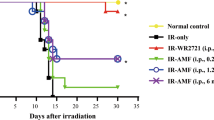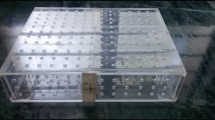Abstract
The objective of our study was to assess the radioprotective effect of flavonoids extracted from Rosa roxburghii Tratt (FRT) and investigate the role of Bcl-2(Ca2+)/Caspase-3/PARP-1 pathway in radiation-induced apoptosis. Cells and mice were exposed to 60Co γ-rays at a dose of 6 Gy. The radiation treatment induced significant effects on tissue pathological changes, apoptosis, Ca2+, ROS, DNA damage, and expression levels of Bcl-2, Caspase-3 (C-Caspase-3), and PARP-1. The results showed that FRT acted as an antioxidant, reduced DNA damage, corrected the pathological changes of the tissue induced by radiation, promoted the formation of spleen nodules, resisted sperm aberration, and protected the thymus. FRT significantly reduced cell apoptosis compared with the irradiation group. The expression of Ca2+ and C-Caspase-3 was decreased after FRT treatment compared with the radiation-treated group. At the same time, expression of prototype PARP-1 and Bcl-2 increased, leading to a decrease in the percentage of apoptosis cells in FRT treatment groups. We conclude that FRT acts as a radioprotector. Apoptosis signals were activated via the Bcl-2(Ca2+)/Caspase-3/PARP-1 pathway in irradiated cells and FRT inhibited this pathway of apoptosis by down-regulation of C-Caspase-3 and Ca2+ and up-regulation of prototype PARP-1 and Bcl-2.














Similar content being viewed by others
References
Qi L, Liu CY, Wu WQ et al (2011) Protective effect of flavonoids from Astragalus 17 complanatus on radiation induced damages in mice. Fitoterapia 82(3):383–392
Zhang XL, Qu WJ, Sun B et al (2005) In vitro antioxidant effects of flavonoids of Rosa. Nat Prod Res and Dev 17(4):396–400
Xu P, Zhang WB, Cai XH, Lu DD, He XY, Qiu PY, Wu J (2014) Flavonoids of Rosa roxburghii Tratt act as radioprotectors. Asian Pac J Cancer Prev 15:8171–8175
Xu P, Yan XQ, Chen HT (2012) Application of flavonoids from Rosa roxburghii Tratt in medicine preparation for protection against ionizing radiation. State Intellectual Property Bureau in the People’s Republic of China. ZL201010570876.1
Deng X, Gao F, May WS Jr (2003) Bcl-2 retards G1/S cell cycle transition by regulating intracellular ROS. Hematopoiesis 102:9
Green DR (2006) At the gates of death. Cancer Cell 9:328–330
Terato H, Ide H (2004) Clustered DNA damage induced by heavy ion particles. Biol Sci Space 18:206–215
Hada M, Georgakilas AG (2008) Formation of clustered DNA damage after high-LET irradiation: a review. J Radiat Res 49:203–210
Tsuchida Y, Tsuboi K, Ohyama H et al (1998) Cell death induced by high-linear-energy transfer carbon beams in human glioblastoma cell lines. Brain Tumor Pathol 15:71–76
Duan X, Zhang H, Liu B et al (2008) Apoptosis of murine melanoma cells induced by heavy-ion radiation combined with Tp53 gene transfer. Int J Radiat Biol 84:211–217
Jinno-Oue A, Shimizu N, Hamada N et al (2010) Irradiation with carbon ion beams induces apoptosis, autophagy, and cellular senescence in a human glioma-derived cell line. Int J Radiat Oncol Biol Phys 76:229–241
Asaithamby A, Chen DJ (2011) Mechanism of cluster DNA damage repair in response to high-atomic number and energy particles radiation. Mutat Res 711:87–99
D’Silva I, Pelletier JD, Lagueux J et al (1999) Relative affinities of poly(ADP-ribose) polymerase and DNA-dependent protein kinase for DNA strand interruptions. Biochim Biophys Acta 1430:119–126
Dantzer F, de La Rubia G, Menissier-De Murcia J et al (2000) Base excision repair is impaired in mammalian cells lacking Poly (ADP-ribose) polymerase-1. Biochemistry 39:7559–7569
Lo¨ser DA, Shibata A, Shibata AK, et al (2010) Sensitization to radiation and alkylating agents by inhibitors of poly (ADP-ribose) polymerase is enhanced in cells deficient in DNA double-strand break repair. Mol Cancer Ther 9:1775–1787
Courtin CM, Delcour JA (2002) Arabinoxylans and endoxylanases in wheat flour. J Cereal Sci 35:225–243
Courtin CM, Roelants A, Delcour JA (1999) Ractionation-reconstitution experiments provide insight into the role of endoxylanases in bread-making. J Agricmtural Food Chem 47:1840–1847
Cervato G, Carabelli M, Gervasio S (2000) Antioxidant properties of oregano 1eaf extracts. Food Biochem 24:453–465
Gudkov SV, Shtarkman IN, Smirnova VS, Chernikov AV, Bruskov VI (2006) GuanOsine and inosine display antioxi dant activity, protect DNA in vitro from oxidative damage induced by reactive oxygen species, and serve as radioprotectors in mice. Radiat Res 65(5):538–545
Robinson CV (1967) Decrease in numbers of mouse spleen nodules with time post-irradiation. Proc Soc Exp Biol Med 124(1):118–122
Spitz DR, Azzam EI, Li JJ, Gius D (2004) Metabolic oxidation/reduction reactions and cellular responses to ionizing radiation: a unifying concept in stress response biology. Cancer Metastasis 23(3–4):311–322
Dizdaroglu M, Jaruga P, Birincioglu M, Rodriguez H (2002) Free radical induced damage to DNA: mechanisms and measurement. Free Radic Biol Med 32(11):1102–1115
Marnett LJ (2000) Oxyradicals and DNA damage. Carcinogenesis 21(3):361–370
Valko M, Izakovic M, Mazur MR, Rhodes CJ, TelSer J (2004) Role of oxygen radicals in DNA damage and cancer incidence. Mol Cell Biochem 266(1–2):37–56
Shen Y, Luo Q, Xu H, Gong F, Zhou X, Sun Y et al (2011) Mitochondria-dependent apoptosis of activated T lymphocytes induced by astin C, a plant cyclopeptide, for preventing murine experimental colitis. Biochem Pharmacol 82:260–268
Xia L, Luo QL, Lin HD et al (2012) The effect of different treatment time of millimeter wave on chondrocyte apoptosiss, caspase-3, caspase-8, and MMP-13 expression in rabbit surgically induced model of knee osteoarthritis. Rheumatol Int 32(9):2847–2856
Mohan S, Abdelwahab SI, Kamalidehghan B, Syam S, May KS, Harmal NSM et al (2012) Involvement of NF-κB and Bcl2/Bax signaling pathways in the apoptosis of MCF7 cells induced by a xanthone compound Pyranocycloartobiloxanthone A. Phytomedicine 19:1007–1015
Kluck RM, Bossy-Wetzel E, Green DR, Newmeyer DD (1997) The release of cytochrome C from mitochondria: a primary site for Bcl-2 regulation of apoptosis. Science 275:1132–1136
Lindsten T, Zong WX, Thompson CB (2005) Defining the role of the Bcl-2 family of proteins in the nervous system. The Neurosci 11:10–15
Bivik CA, Larsson PK, Kagedal KM, Rosdahl IK, Ollinger KM (2006) UVA/B-Induced apoptosis in human melanocytes involves translocation of cathepsins and Bcl-2 family members. J Invest Dermatol 126:1119–1127
Hesketh TR, Smith GA, Moore JP et al (1983) Free cytoplasmic calcium concentration and the mitogenic stimulation of lymphocytes. J Biochem 258:4876–4882
Santella L (1998) The role of calcium in the cell cycle: facts and hypotheses. Biochem Biophys Res Commun 244:317–324
Du C, Fang M, Li Y et al (2000) A mitochondrial protien that promotes cytochrome 19 C-dependent caspase activation by eliminating IAP inhibition. Cell 102:33
Los M, Burek CJ, Stroh C et al (2003) Anticancer drugs of tomorrow:apoptic pathways as targets for drug design. Drug Discov Today 8:67–77
McConkey DJ, Nutt LK (2001) Calcium flux measurements in apoptosis. Methods Cell Biol 66:229–246
Liu B, Jian Z, Li Q, Li K, Wang Z, Liu L et al (2012) Baicalein protects human melanocytes from H2O2-induced apoptosis via inhibiting mitochondria-dependent caspase activation and the p38 MAPK pathway. Free Radic Bio Med 53:183–193
Danial NN (2007) BCL-2 family proteins: critical checkpoints of apoptotic cell death. Clin Cancer Res 13:7254–7263
Yu SW, Wang H, Poitras MF et al (2002) Mediation of poly (ADP-ribose) Polymerase-1 dependent cell death by apoptosis-inducing factor. Science 297(5579):259–263
Huerta S, Gao X, Dineen S et al (2013) Role of p53, Bax, p21, and DNA-PKcs in radiation sensitivity of HCT-116 cells and xenografts. Surgery 154(2):143–151
Yu SW, Andrabi SA, Wang H et al (2006) Apoptosis-inducing factor mediates poly (ADP-ribose) (PAR) polymer-induced cell death. Proc Natl Acad Sci USA 103(48):18314–18319
Moubarak RS, Yuste VJ, Artus C, Bouharrour A, Greer PA, Menissier-de Murcia J, Susin SA (2007) Sequential activation of poly (ADP-ribose) polymerase 1, calpains, and Bax is essential in apoptosis-inducing factor-mediated programmed necrosis. Mol Cell Biol 27(13):4844–4862
Doti N, Reuther C, Scognamiglio PL et al (2014) Inhibition of the AIF/CypA complex protects against intrinsic death pathways induced by oxidative stress. Cell Death Dis 16(5):e993
Lui JC, Kong SK (2007) Heat shock protein 70 inhibits the nuclear import of apoptosis-inducing factor to avoid DNA fragmentation in TF-1 cells during erythropoiesis. FEBS Lett 581(1):109–117
Li CR, Zhou Z, Lin RX et al (2007) Beta-sitosterol decreases irradiation-induced thymocyte early damage by regulation of the intracellular redox balance and maintenance of mitochondrial membrane stability. J Cell Biochem 102(3):748–758
Fang F, Gong PS, Zhao HG et al (2013) Mitochondrial modulation of apoptosis induced by low-dose radiation in mouse testicular cells. Biomed Environ Sci 26(10):820–830
Guo X, Li Q, Shi J et al (2016) Perfluorooctane sulfonate exposure causes gonadal developmental toxicity in Caenorhabditis elegans through ROS-induced DNA damage. Chemosphere 155:115–126
Piao MJ, Kim KC et al (2013) Protective Effect of Fisetin (3,7,3′,4′-Tetrahydroxyflavone) against γ-irradiation-induced oxidative stress and cell damage. Biomol Ther 21(3):210–215
Zeitlin BD, Zeitlin IJ, Nör JE (2012) Expanding circle of inhibition: small-molecule inhibitors of Bcl-2 as anticancer cell and antiangiogenic agents. J Clin Oncol 20 26(25):4180–4188
Acknowledgments
We sincerely thank Dr. Bin-Feng Cheng for the excellent computer-aided drug design assistance and guidance, with a special thank you to Colin Fearon. This study was supported by the Department of Science and Technology Research Project of Henan Province in China (142102310302), the Department of Education Science and Technology Research Project of Henan Province in China (12B310018), and the National Science Foundation of China (U1504824).
Author information
Authors and Affiliations
Corresponding author
Ethics declarations
Conflict of interest
We declare that we have no financial and personal relationships with other people or organizations that can inappropriately influence our work, there is no professional or other personal interest of any nature in any product, service or company that could be construed as influencing the position presented in the manuscript entitled “Flavonoids of Rosa roxburghii Tratt exhibit radioprotection and anti-apoptosis properties via the Bcl-2(Ca2+)/Caspase-3/PARP-1 pathway”.
Electronic supplementary material
Below is the link to the electronic supplementary material.
Rights and permissions
About this article
Cite this article
Xu, P., Cai, X., Zhang, W. et al. Flavonoids of Rosa roxburghii Tratt exhibit radioprotection and anti-apoptosis properties via the Bcl-2(Ca2+)/Caspase-3/PARP-1 pathway. Apoptosis 21, 1125–1143 (2016). https://doi.org/10.1007/s10495-016-1270-1
Published:
Issue Date:
DOI: https://doi.org/10.1007/s10495-016-1270-1




